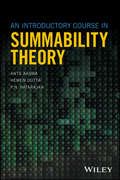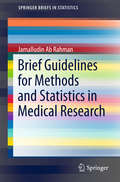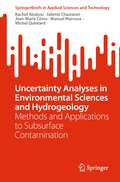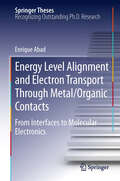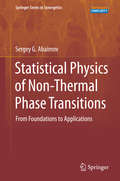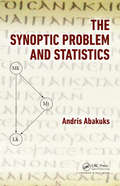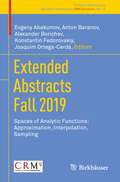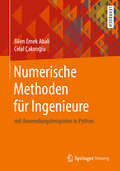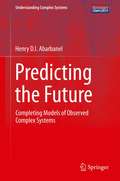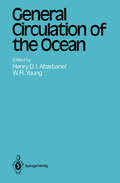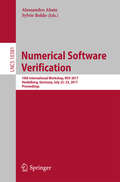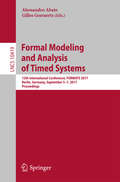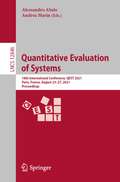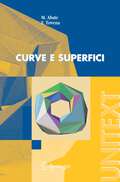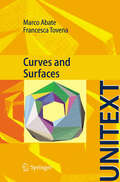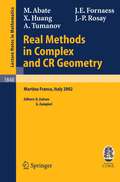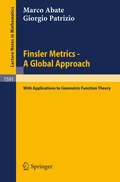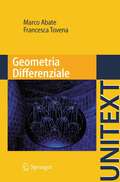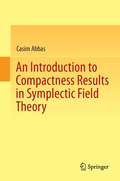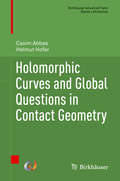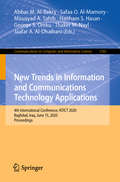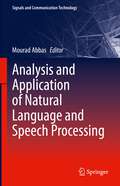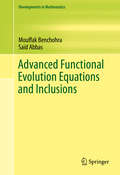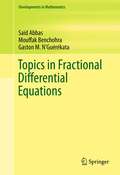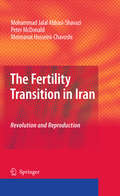- Table View
- List View
An Introductory Course in Summability Theory
by Ants Aasma Hemen Dutta P. N. NatarajanAn introductory course in summability theory for students, researchers, physicists, and engineers In creating this book, the authors’ intent was to provide graduate students, researchers, physicists, and engineers with a reasonable introduction to summability theory. Over the course of nine chapters, the authors cover all of the fundamental concepts and equations informing summability theory and its applications, as well as some of its lesser known aspects. Following a brief introduction to the history of summability theory, general matrix methods are introduced, and the Silverman-Toeplitz theorem on regular matrices is discussed. A variety of special summability methods, including the Nörlund method, the Weighted Mean method, the Abel method, and the (C, 1) - method are next examined. An entire chapter is devoted to a discussion of some elementary Tauberian theorems involving certain summability methods. Following this are chapters devoted to matrix transforms of summability and absolute summability domains of reversible and normal methods; the notion of a perfect matrix method; matrix transforms of summability and absolute summability domains of the Cesàro and Riesz methods; convergence and the boundedness of sequences with speed; and convergence, boundedness, and summability with speed. • Discusses results on matrix transforms of several matrix methods • The only English-language textbook describing the notions of convergence, boundedness, and summability with speed, as well as their applications in approximation theory • Compares the approximation orders of Fourier expansions in Banach spaces by different matrix methods • Matrix transforms of summability domains of regular perfect matrix methods are examined • Each chapter contains several solved examples and end-of-chapter exercises, including hints for solutions An Introductory Course in Summability Theory is the ideal first text in summability theory for graduate students, especially those having a good grasp of real and complex analysis. It is also a valuable reference for mathematics researchers and for physicists and engineers who work with Fourier series, Fourier transforms, or analytic continuation. ANTS AASMA, PhD, is Associate Professor of Mathematical Economics in the Department of Economics and Finance at Tallinn University of Technology, Estonia. HEMEN DUTTA, PhD, is Senior Assistant Professor of Mathematics at Gauhati University, India. P.N. NATARAJAN, PhD, is Formerly Professor and Head of the Department of Mathematics, Ramakrishna Mission Vivekananda College, Chennai, Tamilnadu, India.
Brief Guidelines for Methods and Statistics in Medical Research (SpringerBriefs in Statistics #0)
by Jamalludin Bin Ab RahmanThis book serves as a practical guide to methods and statistics in medical research. It includes step-by-step instructions on using SPSS software for statistical analysis, as well as relevant examples to help those readers who are new to research in health and medical fields. Simple texts and diagrams are provided to help explain the concepts covered, and print screens for the statistical steps and the SPSS outputs are provided, together with interpretations and examples of how to report on findings. Brief Guidelines for Methods and Statistics in Medical Research offers a valuable quick reference guide for healthcare students and practitioners conducting research in health related fields, written in an accessible style.
Uncertainty Analyses in Environmental Sciences and Hydrogeology: Methods and Applications to Subsurface Contamination (SpringerBriefs in Applied Sciences and Technology)
by Rachid Ababou Juliette Chastanet Jean-Marie Côme Manuel Marcoux Michel QuintardThis book highlights several methods and quantitative implementations of both probabilistic and fuzzy-based approaches to uncertainty quantification and uncertainty propagation through environmental subsurface pollution models with uncertain input parameters. The book focuses on methods as well as applications in hydrogeology, soil hydrology, groundwater contamination, and related areas (e.g., corrosion of nuclear waste canisters). The methods are illustrated for a broad spectrum of models, from non-differential I/O models to complex PDE solvers, including a novel 3D quasi-analytical model of contaminant transport, and a site-specific computer model of dissolved contaminant migration from a DNAPL (Dense Non Aqueous Phase Liquid) pollution source.
Energy Level Alignment and Electron Transport Through Metal/Organic Contacts: From Interfaces to Molecular Electronics (Springer Theses)
by Enrique AbadIn recent years, ever more electronic devices have started to exploit the advantages of organic semiconductors. The work reported in this thesis focuses on analyzing theoretically the energy level alignment of different metal/organic interfaces, necessary to tailor devices with good performance. Traditional methods based on density functional theory (DFT), are not appropriate for analyzing them because they underestimate the organic energy gap and fail to correctly describe the van der Waals forces.Since the size of these systems prohibits the use of more accurate methods, corrections to those DFT drawbacks are desirable. In this work a combination of a standard DFT calculation with the inclusion of the charging energy (U) of the molecule, calculated from first principles, is presented. Regarding the dispersion forces, incorrect long range interaction is substituted by a van der Waals potential. With these corrections, the C60, benzene, pentacene, TTF and TCNQ/Au(111) interfaces are analyzed, both for single molecules and for a monolayer. The results validate the induced density of interface states model.
Statistical Physics of Non-Thermal Phase Transitions: From Foundations to Applications (Springer Series in Synergetics)
by Sergey G. AbaimovThis book addresses the application of methods used in statistical physics to complex systems—from simple phenomenological analogies to more complex aspects, such as correlations, fluctuation-dissipation theorem, the concept of free energy, renormalization group approach and scaling. Statistical physics contains a well-developed formalism that describes phase transitions. It is useful to apply this formalism for damage phenomena as well. Fractals, the Ising model, percolation, damage mechanics, fluctuations, free energy formalism, renormalization group, and scaling, are some of the topics covered in Statistical Physics of Phase Transitions.
The Synoptic Problem and Statistics
by Andris AbakuksSee How to Use Statistics for New Testament InterpretationThe Synoptic Problem and Statistics lays the foundations for a new area of interdisciplinary research that uses statistical techniques to investigate the synoptic problem in New Testament studies, which concerns the relationships between the Gospels of Matthew, Mark, and Luke. There are pote
Extended Abstracts Fall 2019: Spaces of Analytic Functions: Approximation, Interpolation, Sampling (Trends in Mathematics #12)
by Evgeny Abakumov Anton Baranov Alexander Borichev Konstantin Fedorovskiy Joaquim Ortega-CerdàThis book collects the abstracts of the mini-courses and lectures given during the Intensive Research Program “Spaces of Analytic Functions: Approximation, Interpolation, Sampling” which was held at the Centre de Recerca Matemàtica (Barcelona) in October–December, 2019.The topics covered in this volume are approximation, interpolation and sampling problems in spaces of analytic functions, their applications to spectral theory, Gabor analysis and random analytic functions. In many places in the book, we see how a problem related to one of the topics is tackled with techniques and ideas coming from another.The book will be of interest for specialists in Complex Analysis, Function and Operator theory, Approximation theory, and their applications, but also for young people starting their research in these areas.
Numerische Methoden für Ingenieure: mit Anwendungsbeispielen in Python
by Bilen Emek Abali Celal ÇakıroğluTechnische Systeme werden von Ingenieur*innen modelliert und durch numerische Methoden simuliert. Dieses Lehrbuch bietet eine unkomplizierte Einführung in numerische Methoden, mit zahlreichen, praxisrelevanten Beispielen, die mithilfe der Programmiersprache Python gelöst werden. In ingenieurwissenschaftlichen Studienrichtungen sowie in allen Forschungsprojekten sind numerische Simulationen unumgänglich, geeignete Methoden aber oft schwierig zu begreifen. Hier erklären Ingenieure die mathematischen Grundlagen der numerischen Methoden in sachlicher, dennoch simpler Sprache, mit konkreten Anwendungsbeispielen auf Papier und am Bildschirm. Die Besonderheit in diesem Buch ist, dass nicht nur Modelle der physikalischen Systeme berechnet und experimentelle Daten bearbeitet werden, sondern der Code in Python Zeile für Zeile angegeben und erklärt wird. Über die Autoren: B. E. Abali arbeitet als Dozent an der Technischen Universität Berlin sowie der Türkisch-Deutschen Universität in Istanbul, und hat an der Technischen Universität München, University of California Berkeley in den USA und Ghent University in Belgien geforscht. C. Çakıroğlu ist Dozent an der Türkisch-Deutschen Universität in Istanbul und hat an der Technischen Universität Braunschweig, dem DLR (Deutsches Zentrum für Luft- und Raumfahrt) und der University of Alberta in Kanada geforscht.
Predicting the Future: Completing Models of Observed Complex Systems (Understanding Complex Systems)
by Henry AbarbanelThrough the development of an exact path integral for use in transferring information from observations to a model of the observed system, the author provides a general framework for the discussion of model building and evaluation across disciplines. Through many illustrative examples drawn from models in neuroscience, geosciences, and nonlinear electrical circuits, the concepts are exemplified in detail. Practical numerical methods for approximate evaluations of the path integral are explored, and their use in designing experiments and determining a model’s consistency with observations is explored.
General Circulation of the Ocean (Topics in Atmospheric and Oceanic Sciences)
by Henry D. I. Abarbanel W. R. YoungThe ocean has entranced mankind for as long as we have gazed upon it, traversed it, dived into it, and studied it. It remains ever changing and seemingly never changing. Each wave that progresses through the. imme diate surf zone on every coast is strikingly different, yet the waves come again and again, as if never to end. The seasons come with essential reg ularity, and· yet each is individual-whatever did happen to that year of the normal rainfall or tidal behavior? This fascination with the currents of the ocean has always had a most immediate practical aspect: shipping, transportation, commerce, and war have depended upon our knowledge, when we had it, and floundered on our surprising ignorance more often than we wish to reflect. These important practical issues have commanded attention from commercial, academic, and military research scientists and engineers from the earliest era of organized scientific investigation. The matter of direct and insistent investigation was from the outset the behavior of ocean currents with long time scales; namely, those varying on annual or at least seasonal cycles. Planning for all the named enterprises depended, as they still do, of course, on the ability to predict with some certainty this class of phenomena. That ability, as with most physical sci ence, is predicated on a firm basis of observational fact to establish what, amorig the myriad of mathematical possibilities, is chosen by Nature as her expression of fact.
Numerical Software Verification: 10th International Workshop, NSV 2017, Heidelberg, Germany, July 22-23, 2017, Proceedings (Lecture Notes in Computer Science #10381)
by Alessandro Abate Sylvie BoldoThis book constitutes the proceedings of the 10th International Workshop on Numerical Software Verification, NSV 2017, held in Heidelberg, Germany, in July 2017 - colocated with the International Workshop on Formal Methods for Rigorous Systems Engineering of Cyber-Physical Systems, RISE4CPS 2017, a one-time, invited-only event.The 3 full papers presented together with 3 short papers, 2 keynote abstracts and 4 invited abstracts were carefully reviewed and selected from numerous submissions.The NSV 2017 workshop is dedicated to the development of logical and mathematical techniques for the reasoning about programmability and reliability.
Formal Modeling and Analysis of Timed Systems: 15th International Conference, FORMATS 2017, Berlin, Germany, September 5–7, 2017, Proceedings (Lecture Notes in Computer Science #10419)
by Alessandro Abate Gilles GeeraertsThis book constitutes the refereed proceedings of the 15th International Conference on Formal Modeling and Analysis of Timed Systems, FORMATS 2017, held in Berlin, Germany, in September 2017. The aim of FORMATS is to promote the study of fundamental and practical aspects of timed systems, and to bring together researchers from different disciplines that share interests in modelling and analysis of timed systems and, as a generalization, hybrid systems.
Quantitative Evaluation of Systems: 18th International Conference, QEST 2021, Paris, France, August 23–27, 2021, Proceedings (Lecture Notes in Computer Science #12846)
by Alessandro Abate Andrea MarinThis book constitutes the proceedings of the 18th International Conference on Quantitative Evaluation Systems, QEST 2021, held in Paris, France, in August 2021.The 21 full papers and 2 short papers presented together with 2 keynote papers were carefully reviewed and selected from 47 submissions. The papers are organized in the following topics: probabilistic model checking; quantitative models and metamodels: analysis and validation; queueing systems; learning and verification; simulation; performance evaluation; abstractions and aggregations; and stochastic models.
Curve e superfici (UNITEXT)
by M. Abate F. TovenaQuesto è un libro di testo sulla geometria differenziale di curve e superfici, adatto agli studenti universitari del secondo e terzo anno dei corsi di Laurea in Matematica, Fisica, Ingegneria e Informatica.
Curves and Surfaces (UNITEXT)
by M. Abate F. TovenaThe book provides an introduction to Differential Geometry of Curves and Surfaces. The theory of curves starts with a discussion of possible definitions of the concept of curve, proving in particular the classification of 1-dimensional manifolds. We then present the classical local theory of parametrized plane and space curves (curves in n-dimensional space are discussed in the complementary material): curvature, torsion, Frenet’s formulas and the fundamental theorem of the local theory of curves. Then, after a self-contained presentation of degree theory for continuous self-maps of the circumference, we study the global theory of plane curves, introducing winding and rotation numbers, and proving the Jordan curve theorem for curves of class C2, and Hopf theorem on the rotation number of closed simple curves. The local theory of surfaces begins with a comparison of the concept of parametrized (i.e., immersed) surface with the concept of regular (i.e., embedded) surface. We then develop the basic differential geometry of surfaces in R3: definitions, examples, differentiable maps and functions, tangent vectors (presented both as vectors tangent to curves in the surface and as derivations on germs of differentiable functions; we shall consistently use both approaches in the whole book) and orientation. Next we study the several notions of curvature on a surface, stressing both the geometrical meaning of the objects introduced and the algebraic/analytical methods needed to study them via the Gauss map, up to the proof of Gauss’ Teorema Egregium. Then we introduce vector fields on a surface (flow, first integrals, integral curves) and geodesics (definition, basic properties, geodesic curvature, and, in the complementary material, a full proof of minimizing properties of geodesics and of the Hopf-Rinow theorem for surfaces). Then we shall present a proof of the celebrated Gauss-Bonnet theorem, both in its local and in its global form, using basic properties (fully proved in the complementary material) of triangulations of surfaces. As an application, we shall prove the Poincaré-Hopf theorem on zeroes of vector fields. Finally, the last chapter will be devoted to several important results on the global theory of surfaces, like for instance the characterization of surfaces with constant Gaussian curvature, and the orientability of compact surfaces in R3.
Real Methods in Complex and CR Geometry: Lectures given at the C.I.M.E. Summer School held in Martina Franca, Italy, June 30 - July 6, 2002 (Lecture Notes in Mathematics #1848)
by Marco Abate John Erik Fornaess Xiaojun Huang Jean-Pierre Rosay Alexander TumanovThe geometry of real submanifolds in complex manifolds and the analysis of their mappings belong to the most advanced streams of contemporary Mathematics. In this area converge the techniques of various and sophisticated mathematical fields such as P.D.E.s, boundary value problems, induced equations, analytic discs in symplectic spaces, complex dynamics. For the variety of themes and the surprisingly good interplaying of different research tools, these problems attracted the attention of some among the best mathematicians of these latest two decades. They also entered as a refined content of an advanced education. In this sense the five lectures of this volume provide an excellent cultural background while giving very deep insights of current research activity.
Finsler Metrics - A Global Approach: with Applications to Geometric Function Theory (Lecture Notes in Mathematics #1591)
by Marco Abate Giorgio PatrizioComplex Finsler metrics appear naturally in complex analysis. To develop new tools in this area, the book provides a graduate-level introduction to differential geometry of complex Finsler metrics. After reviewing real Finsler geometry stressing global results, complex Finsler geometry is presented introducing connections, Kählerianity, geodesics, curvature. Finally global geometry and complex Monge-Ampère equations are discussed for Finsler manifolds with constant holomorphic curvature, which are important in geometric function theory. Following E. Cartan, S.S. Chern and S. Kobayashi, the global approach carries the full strength of hermitian geometry of vector bundles avoiding cumbersome computations, and thus fosters applications in other fields.
Geometria Differenziale (UNITEXT)
by Marco Abate Francesca TovenaL'opera fornisce una introduzione alla geometria delle varietà differenziabili, illustrandone le principali proprietà e descrivendo le principali tecniche e i più importanti strumenti usati per il loro studio. Uno degli obiettivi primari dell'opera è di fungere da testo di riferimento per chi (matematici, fisici, ingegneri) usa la geometria differenziale come strumento; inoltre può essere usato come libro di testo per diversi corsi introduttivi alla geometria differenziale, concentrandosi su alcuni dei vari aspetti della teoria presentati nell'opera. Più in dettaglio, nell'opera saranno trattati i seguenti argomenti: richiami di algebra multilineare e tensoriale, spesso non presentati nei corsi standard di algebra lineare; varietà differenziali, incluso il teorema di Whitney; fibrati vettoriali, incluso il teorema di Frobenius e un'introduzione ai fibrati principali; gruppi di Lie, incluso il teorema di corrispondenza fra sottogruppi e sottoalgebre; coomologia di de Rham, inclusa la dualità di Poincaré e il teorema di de Rham; connessioni, inclusa la teoria delle geodetiche; e geometria Riemanniana, con particolare attenzione agli operatori di curvatura e inclusi teoremi di Cartan-Hadamard, Bonnet-Myers, e Synge-Weinstein. Come abitudine degli autori, il testo è scritto in modo da favorire una lettura attiva, cruciale per un buon apprendimento di argomenti matematici; inoltre è corredato da numerosi esempi svolti ed esercizi proposti.
An Introduction to Compactness Results in Symplectic Field Theory
by Casim AbbasThis book provides an introduction to symplectic field theory, a new and important subject which is currently being developed. The starting point of this theory are compactness results for holomorphic curves established in the last decade. The author presents a systematic introduction providing a lot of background material, much of which is scattered throughout the literature. Since the content grew out of lectures given by the author, the main aim is to provide an entry point into symplectic field theory for non-specialists and for graduate students. Extensions of certain compactness results, which are believed to be true by the specialists but have not yet been published in the literature in detail, top off the scope of this monograph.
Holomorphic Curves and Global Questions in Contact Geometry (Birkhäuser Advanced Texts Basler Lehrbücher)
by Casim Abbas Helmut HoferThis book explains the foundations of holomorphic curve theory in contact geometry. By using a particular geometric problem as a starting point the authors guide the reader into the subject. As such it ideally serves as preparation and as entry point for a deeper study of the analysis underlying symplectic field theory.An introductory chapter sets the stage explaining some of the basic notions of contact geometry and the role of holomorphic curves in the field. The authors proceed to the heart of the material providing a detailed exposition about finite energy planes and periodic orbits (chapter 4) to disk filling methods and applications (chapter 9).The material is self-contained. It includes a number of technical appendices giving the geometric analysis foundations for the main results, so that one may easily follow the discussion. Graduate students as well as researchers who want to learn the basics of this fast developing theory will highly appreciate this accessible approach taken by the authors.
New Trends in Information and Communications Technology Applications: 4th International Conference, NTICT 2020, Baghdad, Iraq, June 15, 2020, Proceedings (Communications in Computer and Information Science #1183)
by Abbas M. Al-Bakry Safaa O. Al-Mamory Mouayad A. Sahib Haitham S. Hasan George S. Oreku Thaker M. Nayl Jaafar A. Al-DhaibaniThis book constitutes refereed proceedings of the 4th International Conference on New Trends in Information and Communications Technology Applications, NTICT 2020, held on June 15, 2020. The NTICT conference was planned to take place in Baghdad on March 11-12, 2019, but due to the COVID-19 pandemic the conference has been postponed on June 15, 2020 and moved to the virtual format.The 15 full papers and 3 short papers presented were thoroughly reviewed and selected from 90 qualified submissions. The volume presents the latest research results in such areas as network protocols, overlay and other logical network structures, wireless access networks, computer vision, machine learning, artificial Intelligence, data mining, control methods.
Analysis and Application of Natural Language and Speech Processing (Signals And Communication Technology Ser.)
by Mourad AbbasAdvanced Functional Evolution Equations and Inclusions (Developments in Mathematics #39)
by Saïd Abbas Mouffak BenchohraThis book presents up-to-date results on abstract evolution equations and differential inclusions in infinite dimensional spaces. It covers equations with time delay and with impulses, and complements the existing literature in functional differential equations and inclusions. The exposition is devoted to both local and global mild solutions for some classes of functional differential evolution equations and inclusions, and other densely and non-densely defined functional differential equations and inclusions in separable Banach spaces or in Fréchet spaces. The tools used include classical fixed points theorems and the measure-of non-compactness, and each chapter concludes with a section devoted to notes and bibliographical remarks.This monograph is particularly useful for researchers and graduate students studying pure and applied mathematics, engineering, biology and all other applied sciences.
Topics in Fractional Differential Equations (Developments in Mathematics #27)
by Saïd Abbas Mouffak Benchohra Gaston M. N'Guérékata Topics in Fractional Differential Equations is devoted to the existence and uniqueness of solutions for various classes of Darboux problems for hyperbolic differential equations or inclusions involving the Caputo fractional derivative. Fractional calculus generalizes the integrals and derivatives to non-integer orders. During the last decade, fractional calculus was found to play a fundamental role in the modeling of a considerable number of phenomena; in particular the modeling of memory-dependent and complex media such as porous media. It has emerged as an important tool for the study of dynamical systems where classical methods reveal strong limitations. Some equations present delays which may be finite, infinite, or state-dependent. Others are subject to an impulsive effect. The above problems are studied using the fixed point approach, the method of upper and lower solution, and the Kuratowski measure of noncompactness. This book is addressed to a wide audience of specialists such as mathematicians, engineers, biologists, and physicists.
The Fertility Transition in Iran: Revolution and Reproduction
by Mohammad Jalal Abbasi-Shavazi Peter McDonald Meimanat Hosseini-ChavoshiConfounding all conventional wisdom, the fertility rate in the Islamic Republic of Iran fell from around 7.0 births per woman in the early 1980s to 1.9 births per woman in 2006. That this, the largest and fastest fall in fertility ever recorded, should have occurred in one of the world’s few Islamic Republics demands explanation. This book, based upon a decade of research is the first to attempt such an explanation. The book documents the progress of the fertility decline and displays its association with social and economic characteristics. It addresses an explanation of the phenomenal fall of fertility in this Islamic context by considering the relevance of standard theories of fertility transition. The book is rich in data as well as the application of different demographic methods to interpret the data. All the available national demographic data are used in addition to two major surveys conducted by the authors. Demographic description is preceded by a socio-political history of Iran in recent decades, providing a context for the demographic changes. The authors conclude with their views on the importance of specific socio-economic and political changes to the demographic transition. Their concluding arguments suggest continued low fertility in Iran.The book is recommended to not only demographers, social scientists, and gender specialists, but also to policy makers and those who are interested in social and demographic changes in Iran and other Islamic countries in the Middle East. It is also a useful reference for demography students and researchers who are interested in applying fertility theories in designing surveys and analysing data.
